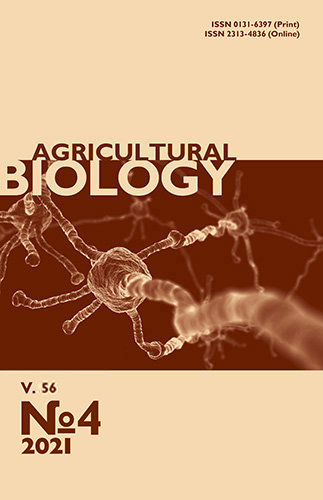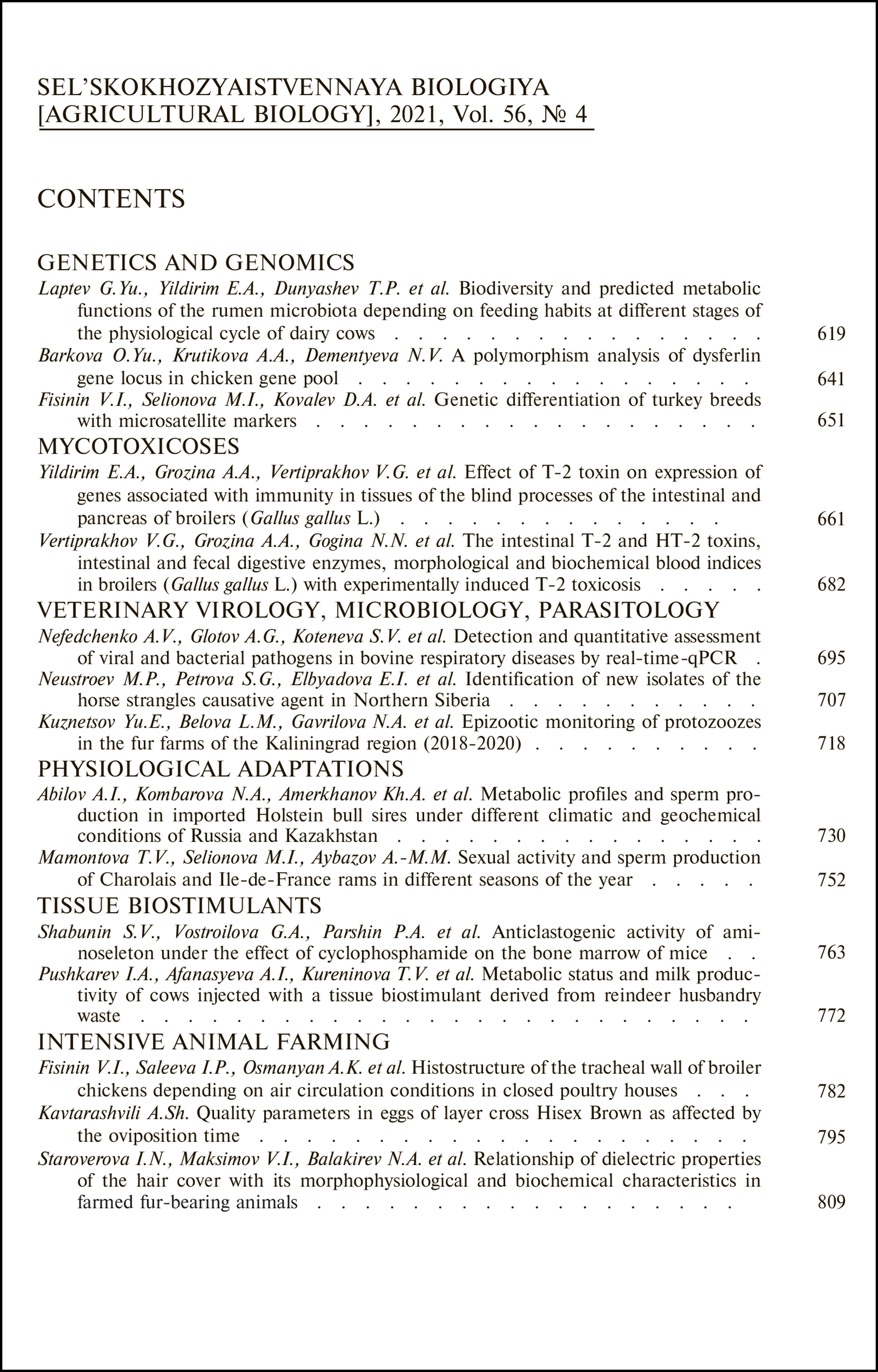doi: 10.15389/agrobiology.2021.4.682eng
UDC: 636.52.58:619:616-099:591.1
Acknowledgements:
Supported financially by the Russian Science Foundation, grant No 20-76-10003 “The investigation of the effects of T-2 and NT-2 toxins on the digestive function in poultry, the development of methods of diagnostics and a new complex preparation for the prevention of mycotoxicoses”
THE INTESTINAL T-2 AND HT-2 TOXINS, INTESTINAL AND FECAL DIGESTIVE ENZYMES, MORPHOLOGICAL AND BIOCHEMICAL BLOOD INDICES IN BROILERS (Gallus gallus L.) WITH EXPERIMENTALLY INDUCED T-2 TOXICOSIS
V.G. Vertiprakhov ✉, A.A. Grozina, N.N. Gogina, I.V. Kislova,
N.V. Ovchinnikova, M.V. Koshcheyeva
Federal Scientific Center All-Russian Research and Technological Poultry Institute RAS, 10, ul. Ptitsegradskaya, Sergiev Posad, Moscow Province, 141311 Russia, e-mail Vertiprakhov63@mail.ru (✉ corresponding author), alena_fisinina@mail.ru, n.n.gogina@mail.ru, irina.kislova1606198@yandex.ru, natalya.o90@mail.ru, vlk.733@mail.ru
ORCID:
Vertiprakhov V.G. orcid.org/0000-0002-3240-7636
Kislova I.V. orcid.org/0000-0001-6399-6886
Grozina A.A. orcid.org/0000-0001-9654-7710
Ovchinnikova N.V. orcid.org/0000-0001-9877-2161
Gogina N.N. orcid.org/0000-0003-1937-286X
Koshcheyeva M.V. orcid.org/0000-0002-0744-1883
Received April 22, 2021
At present over 400 mycotoxins have been identified with mutagenic, teratogenic, embryotoxic, allergenic, and immunosuppressing properties, suppressing cellular and humoral immunity. Trichothecene mycotoxins are prevalent on the territory of Russian Federation, the most abundant and hazardous being T-2 and NT-2 toxins inducing gastroenterites, necroses of skin and mucosa of the oral cavity, disturbances in the function of central nervous system. The exposure limit for T-2 toxin in feeds for poultry is established in SanPiN 2.3.2.1078-1 at 100 μg/kg. Mycotoxin induced injuries of the organs are preceded by functional disturbances affecting the hematological status and enzymatic reactions in the digestive tract; the most exact data on these disturbances can be obtained by in vivo experiments on fistulated birds. We used this approach in our study in combination with the analyses of mycotoxin concentrations in lyophilized samples of duodenal chyme and feces by high-performance liquid chromatography and tandem mass spectrometry (HPLC MS/MS). The aim of the study was the investigation of the T-2 toxin in the gastrointestinal tract and the effects of the toxin on the intestinal activities of the digestive enzymes and morphological and biochemical blood indices in cross Smena 8 broilers with experimentally induced T-2 toxicosis. Birds with chronic duodenal fistulae were fed the feeds contaminated with T-2 toxin in doses from 100 μg/kg (corresponding to the exposure limit statutorily set for chicken) to 400 μg/kg for 2 weeks. The measurements of the T2 toxin in the duodenal chyme and feces evidenced the transformation of T-2 to NT-2 toxin in the intestine and intense absorption of the latter into the bloodstream since its concentration in feces was significantly lower in compare to the duodenal chyme. All dietary doses of T-2 increased the duodenal activities of the total proteases (by 46.3-96.6 %, p < 0.05), lipase (by 16.8-25.5 %, p < 0.05), and amylase (by 99.7 %) at T-2 dose 400 μg/kg while activity of alkaline phosphatase decreased by 23.8-27.9 % (p < 0.05). In the feces the increase in proteolytic activity by 76.0-169.1 % (p < 0.05) and decreases in the activities of lipase (by 23.2 % at T-2 dose 400 μg/kg) and amylase (by 55.1-57.2 %) were found. The activity of trypsin in blood serum decreased by 12.2-22.2 % (p < 0.05) while the increases in the activity of alkaline phosphatase varied from 52.4 % to 5-fold. As a result the phosphatase-protease index increased from 31 to 92 in average. At T-2 dose 400 μg/kg the decreases in the concentrations in blood serum of total protein (by 13.2 %, p < 0.05), glucose (by 13.5 %, p < 0.05), and triglycerides (4-fold) were found. The total leukocyte number in blood decreased by 15.8-16.6 %. At T-2 doses 100 and 200 μg/kg the trend to higher percentage of the lymphocytes was found though the percentage of neutrophils remained unaffected, evidencing the activation of the specific antitoxic protective mechanisms. The inversed correlations between the degree of the transformation of T-2 toxin into NT-2 toxin and tryptic activity in duodenal chyme and phosphatase-protease index in blood serum were found; these correlations can be used in the diagnostic test for T-2 toxicosis.
Keywords: T-2 toxin, NT-2 toxin, T-2 toxicosis, broilers, duodenal chime, digestive enzymes, proteases, lipase, amylase, biochemical blood indices, trypsin, alkaline phosphatase, triglycerides, cell blood composition, leukocytic formula.
REFERENCES
- Awuchi C.G., Ondari E.N., Ogbonna C.U., Upadhyay A.K., Baran K., Okpala C.O.R., Korzeniowska M., Guiné R.P.F. Mycotoxins affecting animals, foods, humans, and plants: types, occurrence, toxicities, action mechanisms, prevention, and detoxification strategies — a revisit. Foods, 2021, 10(6): 1279 CrossRef
- Ivanov A.V., Fisinin V.I., Tremasov M.Ya., Papunidi K.Kh. Mikotoksikozy (biologicheskie i veterinarnye aspekty) [Mycotoxicosis (biological and veterinary aspects)]. Moscow, 2010 (in Russ.).
- Hollander D., Croubels S., Lauwers M., Caekebeke N., Ringenier M., Meyer F.D., Reisinger N., Immerseel F.V., Dewulf J., Antonissen G. Biomonitoring of mycotoxins in blood serum and feed to assess exposure of broiler chickens. Journal of Applied Poultry Research, 2021, 30(1): 100111 CrossRef
- Pereira C.S., Cunha S.C., Fernandes J.O. Prevalent mycotoxins in animal feed: occurrence and analytical methods. Toxins (Basel), 2019, 11(5): 290 CrossRef
- Marin S., Ramos A.J., Cano-Sancho G., Sanchis V. Mycotoxins: occurrence, toxicology, and exposure assessment. Food Chem. Toxicol., 2013, 60: 218-237 CrossRef
- Kovalsky P., Kos G., Nährer K., Schwab C., Jenkins T., Schatzmayr G., Sulyok M., Krska R. Co-occurrence of regulated, masked and emerging mycotoxins and secondary metabolites in finished feed and maize — an extensive survey. Toxins, 2016, 8: 363 CrossRef
- Streit E., Schatzmayr G., Tassis P., Tzika E., Marin D., Taranu I., Tabuc C., Nicolau A., Aprodu I., Puel O., Oswald I. P. Current Situation of mycotoxin contamination and co-occurrence in animal feed—focus on Europe. Toxins (Basel), 2012, 4(10): 788-809 CrossRef
- Biomin® mycotoxin prediction. Available: https://www.biomin.net/science-hub/. Accessed: 20.08.2021.
- Labuda R., Parich A., Berthiller F., Tančinová D. Incidence of trichothecenes and zearalenone in poultry feed mixtures from Slovakia. Int. J. Food Microbiol.,2005, 105: 19-25 CrossRef
- Ibáñez-Vea M., Lizarraga E., González-Peñas E., López de Cerain A. Co-occurrence of type-A and type-B trichothecenes in barley from a northern region of Spain. Food Control, 2012, 25: 81-88 CrossRef
- Golovnya E.Ya., Lunegova I.V., Sviridova A.V. Mezhdunarodnyi vestnik veterinarii, 2016, 4: 62-65 (in Russ.).
- Dzhatdoeva A.A., Selimov R.N., Gracheva T.S., Metal'nikov P.S., Komarov A.A. Uspekhi meditsinskoi mikologii, 2018, 19: 297-298 (in Russ.).
- Jing J.L., Zhang Y., Sun H., Wei J.T., Khalil M.M., Wang Y.W., Dai J.F., Zhang N.Y., Qi D.S., Sun L.H. The response of glandular gastric transcriptome to T-2 toxin in chicks. Food Chem. Toxicol., 2019, 132: 110658 CrossRef
- Sun Y.X., Yao X., Shi S.N., Zhang G.J., Xu L.X., Liu Y.J., Fang B.H. Toxicokinetics of T-2 toxin and its major metabolites in broiler chickens after intravenous and oral administration. J. Vet. Pharmacol. Ther., 2015, 38(1): 80-85 CrossRef
- Yang L., Tu D., Zhao Z., Cui J. Cytotoxicity and apoptosis induced by mixed mycotoxins (T-2 and HT-2 toxin) on primary hepatocytes of broilers in vitro. Toxicon, 2017, 129: 1-10 CrossRef
- Wan Q., He Q., Deng X., Hao F., Tang H., Wang Y. Systemic metabolic responses of broiler chickens and piglets to acute t-2 toxin intravenous exposure. J. Agric. Food Chem., 2016, 64(3): 714-723 CrossRef
- Yang L., Yu Z. Hou J., Deng Y., Zhou Z., Zhao Z., Cui J. Toxicity and oxidative stress induced by T-2 toxin and HT-2 toxin in broilers and broiler hepatocytes. Food Chem. Toxicol., 2016, 87: 128-137 CrossRef
- Chen Y., Han S., Wang Y., Li D., Zhao X., Zhu Q., Yin H. Oxidative stress and apoptotic changes in broiler chicken splenocytes exposed to t-2 toxin. BiomedReserch International, 2019, 25: 5493870 CrossRef
- Lauwers M., De Baere S., Letor B., Rychlik M., Croubels S., Devreese M. Multi LC-MS/MS and LC-HRMS methods for determination of 24 mycotoxins including major phase I and II biomarker metabolites in biological matrices from pigs and broiler chickens. Toxins, 2019, 11(3): 171 CrossRef
- Xue C.Y., Wang G.H., Chen F., Zhang X.B., Bi Y.Z., Cao Y.C. Immunopathological effects of ochratoxin A and T-2 toxin combination on broilers. Poultry Science, 2010. 89(6): 1162-1166 CrossRef
- Kubena L.F., Edrington T.S., Harvey R.B., Buckley S.A., Phillips T.D., Rottinghaus G.E., Casper H.H. Individual and combined effects of fumonisin B1 present in Fusarium moniliforme culture material and T-2 toxin or deoxynivalenol in broiler chicks. Poultry Science, 1997, 76(9): 1239-1247 CrossRef
- Venkatesh P.K., Vairamuthu S., Balachandran C., Manohar B.M., Raj G.D. Induction of apoptosis by fungal culture materials containing cyclopiazonic acid and T-2 toxin in primary lymphoid organs of broiler chickens. Mycopathologia, 2005, 159(3): 393-400 CrossRef
- Huff W.E., Harvey R.B., Kubena L.F., Rottinghaus G.E. Toxic synergism between aflatoxin and T-2 toxin in broiler chickens. Poultry Science, 1988, 67(10): 1418-1423 CrossRef
- Kononenko G.P., Burkin A.A. Fuzariotoksiny v zernovykh kormakh. Veterinarnaya patologiya, 2002 (2): 128-132 (in Russ.).
- Kononenko G.P., Burkin A.A., Zotova E.V. Veterinariya segodnya, 2020, 32: 60-65 CrossRef (in Russ.).
- Kononenko G.P., Burkin A.A., Zotova E.V. Veterinariya segodnya, 2020, 33: 139-145 CrossRef (in Russ.).
- Grozina A.A., Gogina N.N., Kruglova L.M. Materialy XX Mezhdunarodnoi konferentsii. Rossiiskoe otdelenie Vsemirnoi nauchnoi assotsiatsii po ptitsevodstvu (VNAP RF) [Proc. XX Int. Conf. Russian branch of the World's Poultry Science Association (WPSA RF)]. Sergiev Posad, 2020: 211-213 (in Russ.).
- Lauwers M., De Baere S., Letor B., Rychlik M., Croubels S., Devreese M. Multi LC-MS/MS and LC-HRMS methods for determination of 24 mycotoxins including major phase I and II biomarker metabolites in biological matrices from pigs and broiler chickens. Toxins, 2019, 11(3): 171 CrossRef
- Yang L., Zhao Z., Wu A., Deng Y., Zhou Z., Zhang J., Hou J. Determination of trichothecenes A (T-2 toxin, HT-2 toxin, and diacetoxyscirpenol) in the tissues of broilers using liquid chromatography coupled to tandem mass spectrometry. J. Chromatogr. B Analyt. Technol. Biomed. Life Sci., 2013, 942-943: 88-97 CrossRef
- Vertiprakhov V.G., Grozina A.A., Kislova I.V. Sposob otsenki adaptatsii pishchevareniya ptitsy k ingredientnomu sostavu ratsiona. Patent na izobretenie 2742175 C1, 02.02.2021. Zayavka № 2019142448 ot 19.12.2019 [Method for assessing the adaptation of poultry digestion to the ingredient composition of the diet. Patent 2742175 C1, 02.02.2021. Appl. № 2019142448 19.12.2019] (in Russ.).
- European Convention for the Protection of Vertebrate Animals used for Experimental and other Scientific Purposes (ETS № 123) (Strasburg, 18.03.1986). Available: https://norecopa.no/legislation/council-of-europe-convention-ets-123. Accessed: 20.08.2021.
- Borisenko K.V., Vertiprakhov V.G. Ptitsevodstvo, 2018, 10: 20-23 (in Russ.).
- Rukovodstvo po optimizatsii retseptov kombikormov dlya sel'skokhozyaistvennoi ptitsy /Pod redaktsiei V.I. Fisinina [Optimized Poultry Compound Feed Recipes — Recommendations. V.I. Fisinin (ed.)]. Sergiev Posad, 2014: 3-4 (in Russ.).
- Batoev Ts.Zh. Fiziologiya pishchevareniya ptits [Physiology of bird digestion]. Ulan-Ude, 2001 (in Russ.).
- Vertiprakhov V.G., Grozina A.A. Veterinariya, 2018, 12: 51-54 CrossRef (in Russ.).
- Vertiprakhov V.G., Titov V.Yu., Gogina N.N., Grozina A.A. Veterinariya, 2017, 10: 60-63 (in Russ.).
- Vertiprakhov V.G., Gogina N.N., Grozina A.A., Khasanova L.V., Rebrakova T.M. Veterinariya i kormlenie,2017, 6: 17-20 (in Russ.).
- Rothman S.S., Liebow C., Isenman L. Conservation of digestive enzymes. PhysiologicalReview,2002, 82(1): 1-18 CrossRef
- Korot'ko G.F. Rossiiskii zhurnal gastroenterologii, gepatologii, koloproktologii,2011, 4: 14-21 (in Russ.).
- Vertiprakhov V.G., Kislova I.V. Ptitsa i ptitseprodukty, 2020, 1: 44-46 CrossRef (in Russ.).












